I can still remember it. My first fishing rod and reel that my father bought specifically for me. I didn't have to share it with any of my siblings.
Years later, when I joined the military, that same rod traveled to my first duty station. About 50 years later, my fishing rod was finally used up and discarded. The fishing reel is still in my reel box.
If you are beginning a new fisherman (or fisherwoman) journey, you will find this article of exceptional value. Suppose you are preparing a young family member for their first fishing pole. If you take my advice and recommendations, you will establish a base for a future of great memories, and tales of great fishing experiences, and very possibly give a gift that might genuinely last a lifetime.
When I look back 60 years later, I can still envision the striped cord that strapped the fishing line guides to the black and silver pole. I can vividly remember the first bass I caught. Memories lasted a lifetime and still encourage me to get out my fishing poles and head out to the creek or the lake. I don't believe anyone who gets that first thrill of a fish taking their bait will ever forget it.
And so it goes, but it all starts with a fishing pole!
How did I choose the 'Best Fishing pole' for the beginner fisherman? It was easy because I have personal experience with the pole I recommend. I use it, and I currently own at least three of these poles and have owned more than 7 of them in my lifetime.
Usually, in a review, you might see a listing of several poles in this post. But I look at this subject from the aspect of what will give the new fisherman the greatest opportunity for success and happiness for the remainder of their life.
I have introduced many new fishermen to the sport. And have had hundreds of conversations with other fishermen regarding our fishing equipment. I have owned at least 50 fishing rods, and while my wife isn't exactly thrilled, I still own most of them!
(You might note that I haven't included fly-fishing rods in my review. Fly fishing is an art form, and the level of expertise required to wield that fly rod exceeds most people's perceptions of a beginner fisherman.)
In addition to my personal experience, though, I did conduct an actual investigation of the product I will recommend. I have identified genuine reviews from other users and researched the product on the manufacturer's website. I wanted to ensure that what I have experienced was like what other fishermen who have purchased and used these products also experienced.
The reality of my personal experience with this product is that I can say without any reservation that these fishing rods will meet all of your expectations.
Rods? - Plural? Read on, and you will understand, even if you only buy one.
Oh, and one other thing. I am not a paid spokesman for nor am I an affiliate for the manufacturer of this fishing gear. I am in the business of writing validated reviews of products.
These reviews are based on thorough research and represent my best advice on the subject. If you go to Amazon and choose to make a purchase, I may be paid as a referring resource for qualified purchases, but you can still get the same price, even if it is on sale.
What should a first fishing rod be?
The right fishing rod should not wear out for years. The right fishing rod will be highly resistant to breakage. The wrong fishing rod can make fishing not fun. More than one fishing pole has been hand-launched into the water by a frustrated fishing person.
The first fishing pole should bring great joy and create a foundation for an extended fishing life. What makes the difference in these experiences is ensuring that the rod matches the circumstances the fisherman expects to encounter.
Getting to the right matchup
What expectations do you foresee for the use of this new fishing pole? Close your eyes and imagine where and how you anticipate the new fishing pole will be used.
Will it be used primarily for saltwater fishing for big heavy fish species, or will it be used for freshwater fishing for smaller specimens? Will it be used to troll for fish from a boat? Will it be used to cast live bait or lures or jigs? Will the new owner of the pole be a young child, or is it for Dad or Mom?
I will discuss some of these factors and combine aspects where possible. I'll give you a good idea of which fishing rod will work for the circumstances you can identify for now.
I won't present you with the most expensive option for a fishing rod. I am recommending a rod that I know will last for many years and continue to fulfill its designed functionality for those same years. Amazingly, this rod choice is nearer to the lower-end cost than the other thousands of rods out there.
I will not be presenting rod and reel combos either. Rod and reel pairings are made to give the appearance of extra value. However, the reel is a workhorse in the pairing, and this is where the cost-cutting occurs in these combo sales. Saving a few dollars on a fishing reel will not make you or the receiving fisherman any happier.
The price point for the fishing rods I am reviewing will easily allow you to afford a good quality fishing reel to attach to your new fishing rod, with the net result that you will have a combination that will last for many years.
Characteristics That Will Matter
Saltwater or Freshwater?
A great feature of the fishing rod I recommend is that regardless of where you take this rod fishing, the water environment is not a factor. These fishing rods have components that will work and last whether used for either freshwater or seawater. If used for saltwater fishing, a simple wipe down with water from your kitchen sink, and using a soft clean cloth, will permit this pole to last for years.
What Species will you target?
The most critical characteristic is the anticipated fish species you will attempt to catch during your fishing trips. This characteristic will directly define the power rating of the fishing rod. Bass fishing for a big bass that lives in the weeds and fights like a tiger on a rope will require higher power ratings than fishing for even large walleye caught on a jighead.
Match the Rod Power to the line weight.
You should also know that matching the fishing rod power to the recommended line weight characteristics is essential. A mismatch will inevitably lead to unsatisfactory fishing experiences. The casting performance of the rod will be poor if the line weight doesn't fit the pole's design.
Available Configurations.
There are five power ratings available for this fishing rod, starting from the lightest to the heaviest you have:
1) Ultralight - The Ultralight is available in 4' 6" and 5" lengths. They are designed for small fish from a few ounces to 3 or 4 pounds. Line weights from 2-6lb strength. These ultralight rods are great fun even when catching small fish, (better yet, ask my wife about hooking a 19 lb. Northern Pike on an ultralight)! Be prepared for excitement.
2) Light - Light power fishing rods are available in 5', 5'6", 6', and 6'6" lengths. When fishing for species that are one lb. to 10 lb. or maybe 12 lb. fish, this pole will provide a fantastic experience. The line weight recommended for this pole is a 4-10 lb test line. Lighter rods are a great way to experience fishing as a beginner.
Please note that a 10lb fish can create much more stress on the fishing line than their weight suggests. That is why drag adjustability on a fishing reel is available. Additionally, the fishing pole flexes or bends as the fight with the fish occurs. This flexing is what allows a big fish to be caught on fishing line made for weight far below the actual weight of the fish being fought.
It is possible to catch a 20 lb. fish on a six lb. test fishing line, but it is also possible to break your fishing line trying to land a 4 lb trout on line tested for 8 lbs.
3) Medium - Medium power rods from this series of poles are available in 5', 5'6", 5'10", 6',6'6", 7', and 9' lengths. These rods are designed for bigger fish and heavier line strengths from 6-15 lb. Medium power rods are the most versatile power range for this pole series.
Although if your targeted species are generally small, you will be more satisfied with a lighter power rod. As you gain experience with different fish species, you can tackle fish from 1.5 lbs to 25 lbs or even larger with this rod weight and 15 lb. test fishing line.
4) Medium Heavy - Medium Heavy power fishing rods are available in 6', 6'6", and 7' lengths. The Medium Heavy series of these rods will easily handle bigger fish with a lot of fight and will work best with line weights from 8-20 lbs.
Fishing for Bass or other species that hide in heavy grass will be best pursued with a pole in this power rating. This pole will be better fitted to give a hard pull on a fish that will tangle your line in the surrounding grass or weeds.
5) Heavy - The manufacturer produces two fishing rods in the Heavy power category. These rods are only available as one-piece rods (they don't allow you to break them down into two pieces for transport).
They are available in 4'9" or 6' lengths. Although the technical specs identify these rods as having a line rating of 8-20lbs, These fishing rods are not typically used to cast lures.
Instead, they are usually used in boat fishing, often with heavy-weight lures or baited hooks and sinkers. They can be used with line weights up to 100 lb test and with large spool reels. Choose this model to catch big, challenging fish like Halibut or King Salmon.
Two-piece rods
In the grouping of rods I specified above, I specifically identified fishing rods that are two-piece rods. Why?
Fishing rods that are too long are frequently broken by slamming the tip of the rod in a car door. This is can usually be avoided by having a two-piece fishing rod that can be easily broken down into about half of its length. This allows the rod to be easily transported and carried to the shore or boat where the fishing takes place.
Many fishing rods are available as one-piece rods, and those models have a place in the arsenal of fishing equipment that fishermen will encounter. However, I have never met a fisherman with more than one year of fishing experience with only one fishing rod, and neither will you. For the beginner, I recommend sticking with a two-piece fishing rod if they are available in the action and length you want.
For a beginner, a fishing rod that will answer most of the needs will be a medium or light power two-piece rod in length close to the user's height. In the case of a youngster, purchase a length relative to the height you expect them to reach as a young adult. They will adapt to the size as they learn to cast and will likely continue to use this fishing rod throughout their life.
Just a note on fishing rod length
A longer rod will create more momentum during the cast, meaning it can achieve longer casts from a longer fishing rod. But heed this warning; there is a downside to the math!
A 9' medium weight fishing rod will get the best performance with a 4 lb to 20 lb line weight and a lure weight up to 3/4 oz. I can virtually guarantee that if you use a 10-12lb test line with a 3/4 oz lure on this 9 ft rod and you try to cast further and fast, you will likely create enough force at the tip of the line to break off your lure as it sails 250 feet across the lake! You will not appreciate the result when you realize too late that you just threw away a $10 fishing lure.
So What Is This Mystical Fishing Rod?
At some of the most reasonable prices imaginable, the best beginner fishing rods are manufactured by Pure Fishing under the brand name Ugly Stik. Specifically, these rods evaluated in this review are the Ugly Stik GX2 series.
The manufacturer of Ugly Stik has changed hands at least twice since the first one was manufactured, but the quality of these rods has stayed the same over the years. If you buy one today, it may even last longer than some originals did.
The materials in use today are actually an improvement over those in the past so you can expect a long life for this as a first fishing pole.
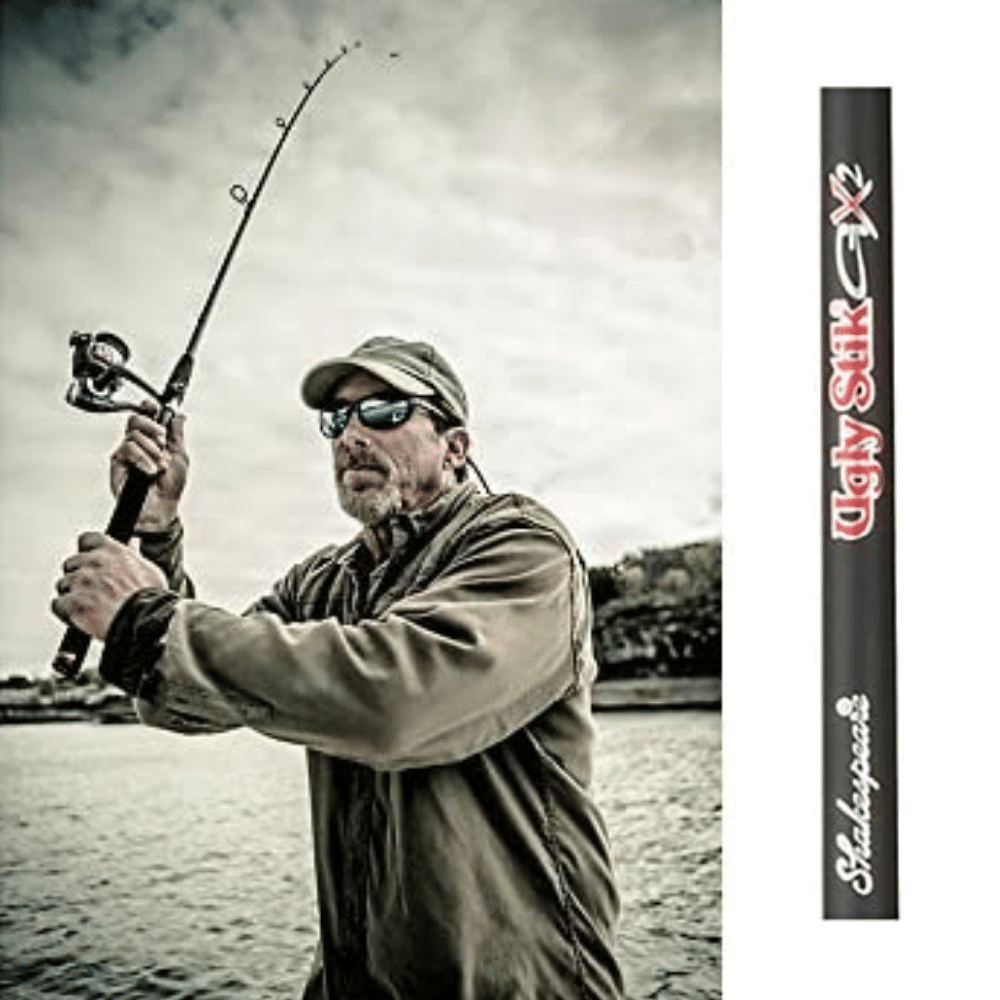
Ugly Stik GX2 Spinning Fishing Rod
Find the size and best power for your beginner
Why This Rod is Preferrable
Ugly Stik manufactures higher-grade fishing rods than the GX2 series. However, the customer satisfaction ratings are just as high with the GX2 as with their higher-grade Elite series (cork handles available with that series).
The Elite series rods in the lower power ratings typically come with cork handles. Cork handles give more sensitivity to the fishermen's hands. This permits better bite sensing at the user's hand than the foam handles of the GX2 series.
I used their spinning fishing rod specifications to identify the available lengths and power ratings. The specifications for the casting fishing rods in the GX2 series are very closely comparable.
What Else to Consider
Casting rods should not be considered for beginner fishermen. If an experienced user is training them, casting reels may be a consideration. Many professional tournament fishermen use casting reels to great advantage.
To identify a casting rod, look at the handle. A rod that has a trigger finger placement hook on the handle beneath the location of the reel seat is a casting rod. The finger hook allows for one-hand casting of the fishing rod. The line guides (metal hoops that the line travels through) are smaller than spinning rods. The rod is held with the reel on top of the rod.
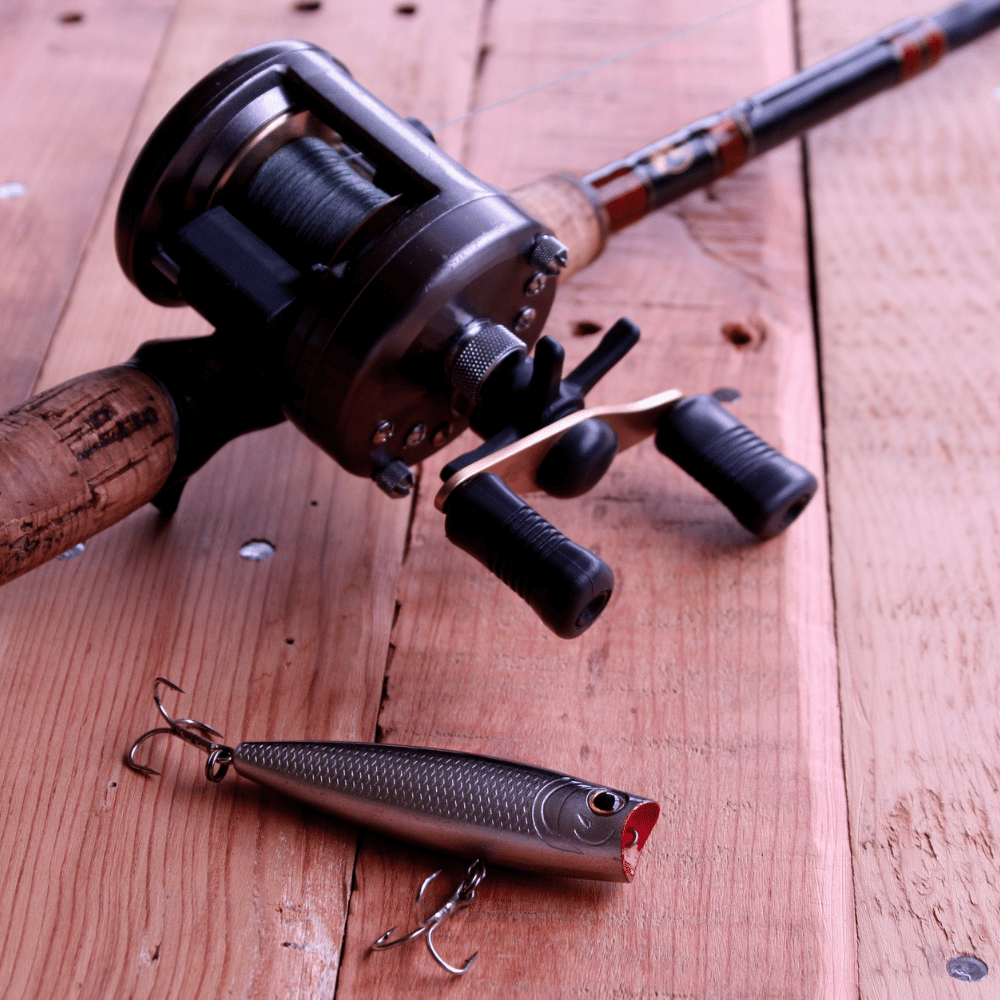
However, beginner fishermen may experience frustration if they start with a casting rod and reel combination and don't have a casting coach or an experienced angler that can help them with the problems that can arise with a casting reel.
The outrage caused by a unique fishing problem called a "bird's nest" (a tangled web of fishing line that can take hours to undo) might result in the fishing rod and reel flying out into the water!
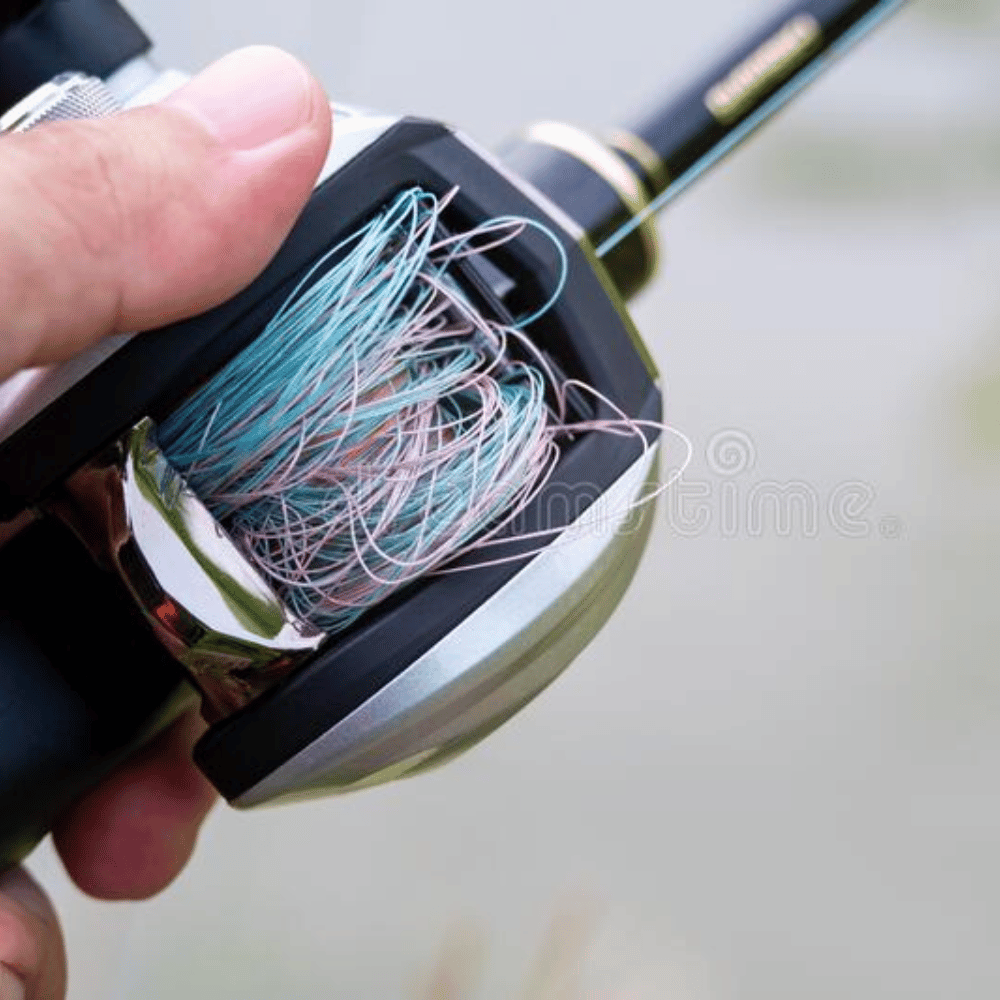
Reels called spincast reels will attach to a casting rod. Spincast reels are frequently purchased for and used by new young fishermen because of their ease of use. If you believe these types of reels will be the best for your beginner fisherman, then choose one of the casting rods with the right characteristics for your chosen species of fish.
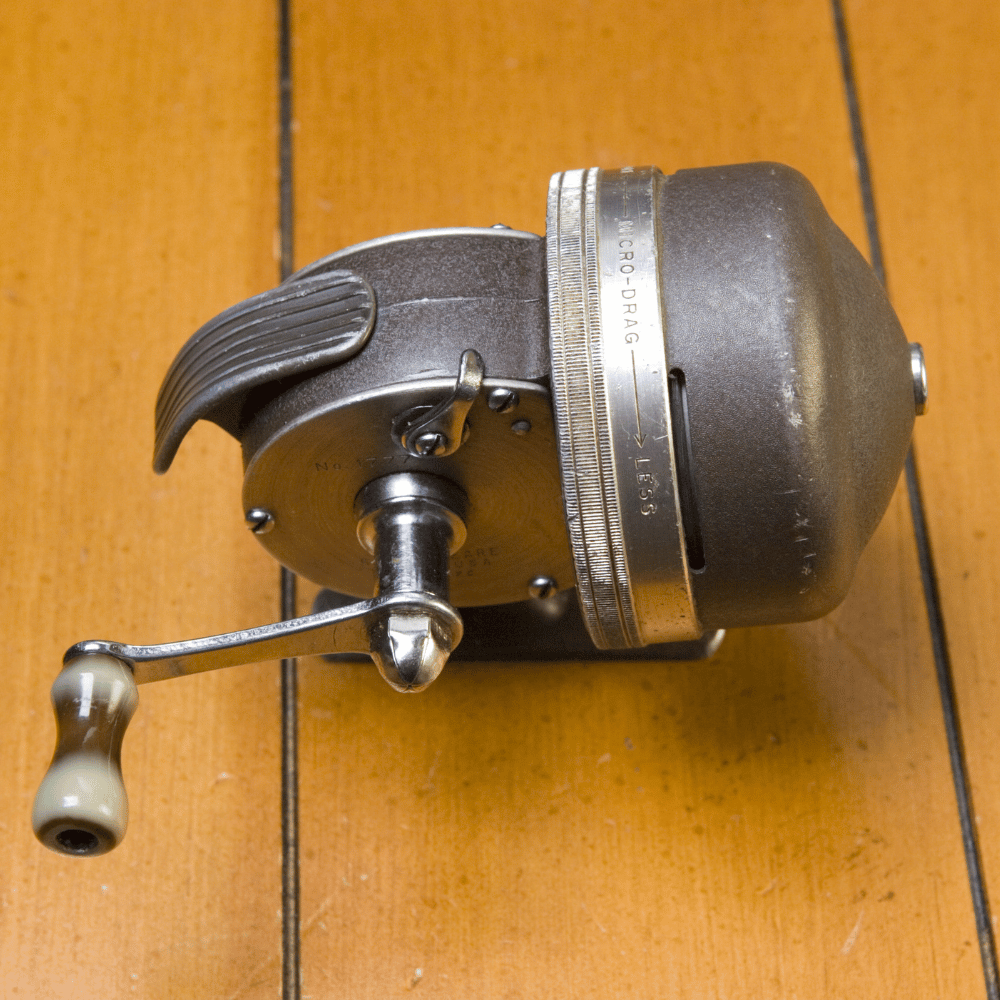
Spinning rods do not have that hook. Spinning reels mount to the rod and hang down into the casting hand. This permits easy casting with one hand as well. Spinning reels are also very easy to adapt to. This is why I specifically reviewed the spinning fishing rods.
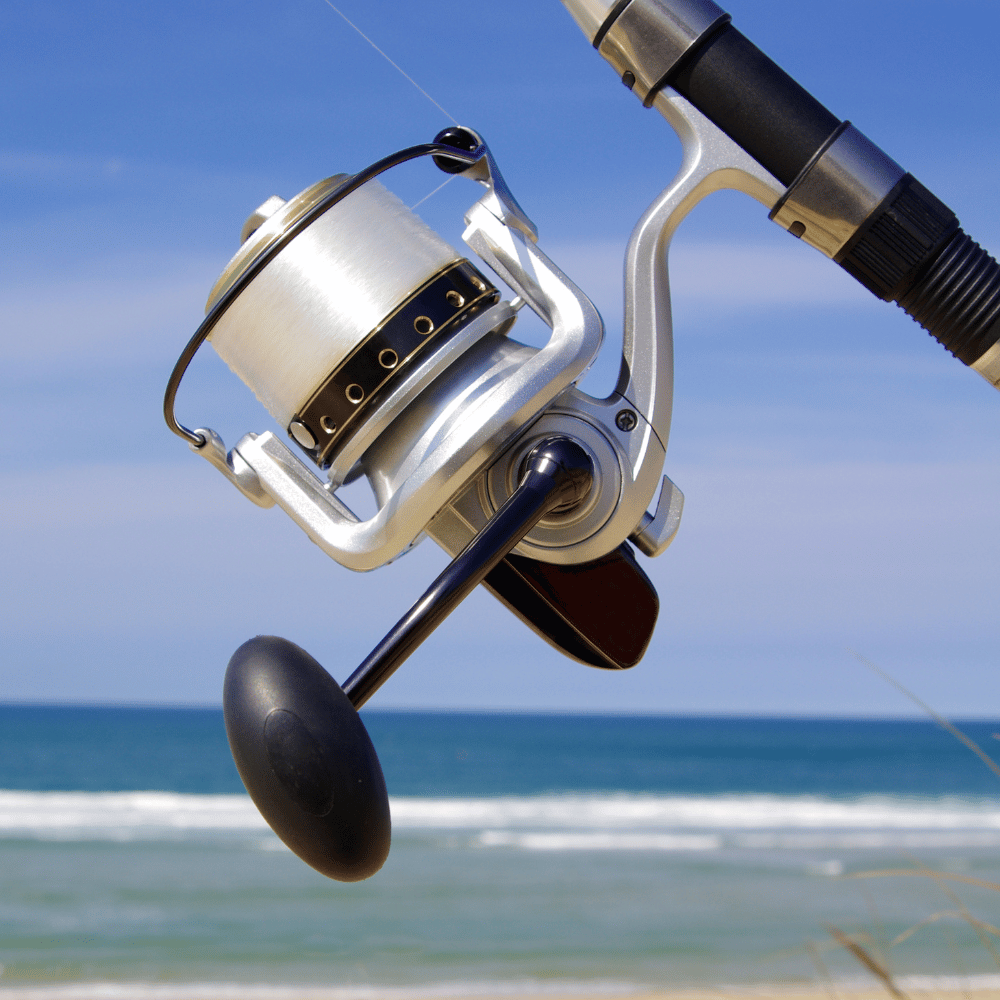
Why I love the Ugly Stik GX2.
The Ugly Stik GX2 series Fishing rods have some of the highest reviews from the fishermen who use them. Many fishermen are like me and own multiple rods from Ugly Stik. For the price, there are not many rods that will last as long.
The manufacturer's warranty is seven years for defects in materials or workmanship.
One of my first Ugly Stik poles had ceramic line guide inserts. I wore them out. Fortunately, the newest versions have polished stainless steel guides. I don't think I could wear these out but, they can be crushed if stepped on or if they are closed in a car door. This can render the rod almost useless, so even though they aren't expensive, if you abuse them, they won't last. So, be careful with them.
They are made from a combination of fiberglass and graphite and are almost indestructible. I have never had one of these rods break. I have seen both pure fiberglass rods and pure graphite rods break. Fiberglass rods of yesteryear often aged badly, and the glass rod body will be more susceptible to breakage as they age.
I don't think it is possible to tie the ultralights into a knot, but sometimes when you watch a big fish fighting on one of these rods, it almost looks like they are bent in half.
Personally, I would love to catch a 5lb Rainbow trout on an ultralight rod with a 4lb test fishing line. OMG, that would be a fight, and I know the rod would handle it.
The molecular structure of Graphite can create the opportunity to permit breakage if the rod is struck against something like a tree or if the fish is too large for the rod design.
As for the Ugly Stik, I had only seen one break when it slammed into a car door (p.s. this type of damage is not covered by the warranty).
Finally, these rods are susceptible because of the partial graphite construction. You can feel the sensitive bite of a frying pan-size walleye even on the medium-weight rods. It is also easy to feel the bite of a trout when retrieving a top water spinning lure across a pond.
Best Fishing Rod for Beginners FAQs
If you or a youngster you care for decide it is time to get your first fishing pole, you will find many choices on the market. This is why making a knowledgeable decision for a new buyer is very frustrating.
There are hundreds, perhaps thousands of different poles and almost no way to decipher the difference. Why is one pole with a reel $22.95 and another pole just down the row marked at $229.50?
So, are these choices confusing? The following questions are provided to give you some additional information about concerns that shoppers are trying to decide on before buying a fishing pole for the beginner fisherman.
Which type of fishing rod is best for beginners?
The best beginner fishing rod is a rod selected for the type of fish that they are likely to pursue regularly for the next 5 - 7 years. Do not expect this to be their only fishing rod because the sport of fishing creates avid followers, and they will likely become owners of many rod and reel combinations.
If the pole is purchased for a young person, don't buy the little fiberglass rod and reel combination setups you find at the big stores (usually red, pink, or green). Get them a rod with a warranty and something they will cherish for years. Fishing is a lifelong adventure.
What is a good beginner fishing setup?
A beginner fishing setup should not be considered a disposable item. Assume it will be a lifetime investment. Not expensive but not cheap either.
Get a fishing rod matched to the height (or expected height) of the fisherman. The pole must be matched to the reel. A spincast reel should be affixed to a casting rod while a spinning reel should be matched to a spinning rod.
For most freshwater fishing, get a medium or medium-light fishing rod and a good-quality reel that matches the design of the fishing rod. As a general rule of thumb, a beginner should start with a spincast reel and casting rod, or with a spinning reel and rod. Rod and Reel combo packaged deals can be okay, but often the fishing reel in these setups will not last as long as the fishing rod.
What is a good fishing pole for all fish?
A good fishing pole that can handle most fishing needs will be about a 5'6" to 6'6" two-piece pole with the rod power in the medium to medium-light power rating. It should carry a good manufacturer's warranty and be rated for line strengths between 6-20 lb test.
Remember that a pole is an outdoor tool. It will get dirty and will get wet. It will get gooey and thus must be able to withstand some abusive situations. The fishing rod I review in this article will meet all the criteria for a good fishing pole and withstand the environments it will be exposed to. The Best Fishing Pole for Beginners (Memories for a Lifetime) by Validated Views.
How do you pick the right size fishing rod?
Size is a relative term. Fishing rods have length sizes. The length relates directly to how far a bait can be cast. A general rule of thumb for length is approximately equal to the height of the fisherman that will use it.
Young people getting their first fishing pole should be encouraged to use a pole that is longer than they are. They will grow into the fishing rod.
Another size measurement is the power rating, and this is usually related to the fighting power of the fish that you are targeting. Fishing line ratings are there to identify the recommended monofilament line weight rating for the pole's ability.
There is one other rating that sometimes comes up, and that is the speed at which the pole pulls against a striking fish when the fisherman sets the hook. Slow, Moderate, and Fast. Most fishermen use a Fast rating if it is identified. A fast rod will set the hook quicker which is usually a better circumstance for beginner fishermen.
Which is better, a one-piece or two-piece fishing rod?
Two-piece fishing rods are easier to transport and less likely to fail due to breakage. These poles are not quite as strong structurally as a one-piece rod, but the differences are generally negligible in most circumstances.
A one-piece rod is typically a specialty rod designed to be more resilient in fighting strong fish. Heavy rods for large fish are usually constructed as one-piece rods.
There is another group of fishing rods that are not covered in the article but have some exciting characteristics. The collapsable or telescopic fishing rod can easily be carried in a bag and is suitable for carrying with you in your car if you have a half-hour lunch break with a fishing hole nearby. They also can be carried easily in a backpack.
What size rod is best for freshwater fishing?
Fishermen will need to consider many variables for selecting a freshwater rod (i.e., size, power, line weight, and action on a fishing rod.) There is no one size fits all circumstances.
However, an excellent general-purpose fishing rod for most lakes and small rivers would be a 6-foot, medium-weight spinning rod and reel combination with an 8-lb test monofilament line. Most fish species in freshwater fishing would be susceptible to being caught with this configuration.
What is a spinning fishing rod vs. a casting fishing rod?
There are two basic configurations for rod and reel configurations. There is a lot of difference in the technique of casting one compared to the other. Most fishermen adapt to one or a different design. Arguably, there is little difference in their ability to catch fish. Beginner fishermen often find Casting configurations more challenging to adapt to.
You can identify a rod as a casting rod if it appears to have a trigger finger placement hook on the handle underneath the location of the reel seat. The finger hook allows for one-hand casting of the fishing rod.
Spinning rods do not have that hook. Spinning reels mount to the rod and hang down into the casting hand. This reel mounting method permits the fisherman to cast with one hand too.
Can you turn a one-piece fishing rod into a two-piece?
I cannot contain my humor here. If you break it or cut it in half, you will have two pieces that together make a worthless fishing pole!
Some DIYers might be tempted to affix a coupling fixture to bring the two pieces together again. Save yourself time and expense. It will be wiser to go out and buy a new two-piece fishing rod.
What is the Best Fishing Pole for Your Beginner Fisherman?
A great experience for a beginner fisherman will create a lifelong fisherman. And the real point of getting a perfect beginner fishing rod is to create that great experience.
Do your best to buy the right pole in the first place. The beginner will be ever thankful and will likely never forget the great experiences they have with the new pole.
So go back to the measurements in this article, do the evaluation for yourself, and identify the specific pole configuration that will satisfy the expected use for the new pole. Then click the find your price button and select the best fishing pole for your beginner fisherman.
I wrote this guide to provide you with a better understanding of fishing poles. With it, you can trust your decision to purchase one of these fishing rods. Thank you for taking time out of your day to review my article. Now get set to go fishing!




